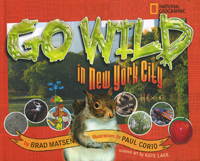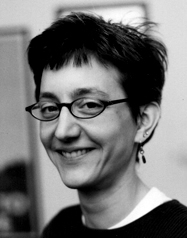Going Wild With Science In The City
Who says that environmental science can only be taught in the woods or a swamp filled with tadpoles and bugs? Certainly not TC's Urban Science Education Center, which will soon present a city-based environmental science program to teachers in New York City public schools.
Who says that environmental science can only be taught in the woods or a swamp filled with tadpoles and bugs? Certainly not TC's Urban Science Education Center, which will soon present a city-based environmental science program to teachers in New York City public schools. The program will enable teachers to create lesson plans based on the book Go Wild in New York City, a lively and colorfully illustrated exploration of scientific facts about the Big Apple. The book was produced by Jessica Marshall, PhD, executive director of the Urban Nature Media Workshop, and published by National Geographic in 2005. Together, with support from philanthropist Theodore W. Kheel's Nurture Nature Foundation, the Urban Science Education Center and the Urban Nature Media Workshop are collaborating to create standards-based teacher training programs, workbooks for teachers and parents, and complementary Web sites that draw on and extend Go Wild in New York City and other forthcoming Go Wild books.
Angela Calabrese Barton, Associate Professor in Science and Education and founding director of the Urban Science Center, says the idea that city kids don't connect to the nature around them is a myth. "We know from our work with youth that they do connect, and we know from books like Go Wild in New York City that there are many ways in which teachers can explore the world around them to further engage kids in the natural world that is New York City."
So what exactly does science in New York City look like? The book describes things like where the city's water comes from, how it gets to our kitchens and bathrooms and where it goes after it is used; the rocks beneath us and those that tower above us in the form of skyscrapers; the sky and the air we breathe and how to keep it clean; the plants and wildlife in the city parks; and how much garbage New York City makes every day (over 9,000 tons-'"enough to fill up the Empire State Building).
For each of the seven chapters in Go Wild, the Center is developing a series of "deep explorations" -'"one- to four-week-long interdisciplinary activities that teachers can do with their students-'"that draw on the New York City environment and get students using math and literacy skills, as well.
"We're finding out in elementary settings that students really do have the connective skills to write about what they know and to use the connections together with their math and science," says Felicia Moore, who also teaches in the Science Education program at TC.
The Urban Science Education Center also is running an after-school Go Wild program.
"It's a lot of fun because kids can get outside the classroom and engage with adults doing science a little bit differently," says Calabrese Barton.
The Go Wild project is a natural fit with the Center's mission, which is to promote science in impoverished urban settings in order to reach minorities that are underrepresented in the sciences. Ten fellows funded by the Hearst Foundation work with the teachers at eight partner schools in New York City's Region 10 schools in Central Harlem.
The Center also designed and conducts workshops for New York City fifth grade teachers. And in the summer, it will hold a working conference that will bring together school-university teams to launch a U.S. Go Wild project. For its part, the Urban Nature Media Workshop is currently working on a Go Wild national edition that Marshall says will be "an overview of the -'gee whizziest' facts about cities from coast to coast."
For Calabrese Barton, it's all part of creating "a sense of agency, for both teachers and students, when it comes to acting on and with the science in their lives. That's especially important in the city because of the density of people, animals, plants, machines and things living together."
Published Thursday, Feb. 23, 2006

